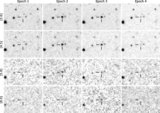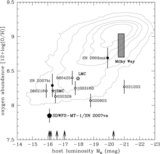Image Details

Caption: Figure 2.
Light curves of the transient. Top panel: observed optical and mid-IR magnitudes. For display purposes, the IRAC points are
offset by −3 days [3.6], −1 day [4.5], +1 day [5.8], and +3 days [8.0]. The right
y-axis shows the absolute magnitudes without
K-corrections. A normal Type II SN would peak at
M
![]() −20 mag at 3.6 μm. The gray area marks the region when the mid-IR transient was not visible to airmass <1.5. The large dark
green symbols mark the CRTS upper limits found by stacking the three nearest epochs (small symbols) into one image. The RAPTOR
upper limits (purple symbols) are stacks of 21–62 images. The QUEST upper limits (orange) are derived based on 1–4 stacked
images per epoch. The large symbol for QUEST combines the four nearest epochs. Bottom panel: points from the upper panel converted
to luminosity as λ
F
λ.
−20 mag at 3.6 μm. The gray area marks the region when the mid-IR transient was not visible to airmass <1.5. The large dark
green symbols mark the CRTS upper limits found by stacking the three nearest epochs (small symbols) into one image. The RAPTOR
upper limits (purple symbols) are stacks of 21–62 images. The QUEST upper limits (orange) are derived based on 1–4 stacked
images per epoch. The large symbol for QUEST combines the four nearest epochs. Bottom panel: points from the upper panel converted
to luminosity as λ
F
λ.
Copyright and Terms & Conditions
© 2010. The American Astronomical Society. All rights reserved.







